An avatar in Sanskrit means “descent.” It is the manifestation of God, a deity, or the supreme self in an earthly embodiment. Dashavatara of Vishnu means ten avatars of Lord Vishnu; he manifested on earth to sustain the dharma.
During different Yugas, Vishnu incarnated to establish righteousness or dharma. For instance, in Treta Yuga, he manifested as Rama Avatar to liberate the world from Ravana. In Dwapara Yuga, he played the central role of Mahabharata as Sri Krishna.
Vishnu is all-pervading; he has Innumerable incarnations. Srimad Bhagavatam (Canto 1, chapter 3) says there are innumerable incarnations of Lord Vishnu. 24 Avatars of Vishnu are mentioned in the chapter.
Dashavataram order
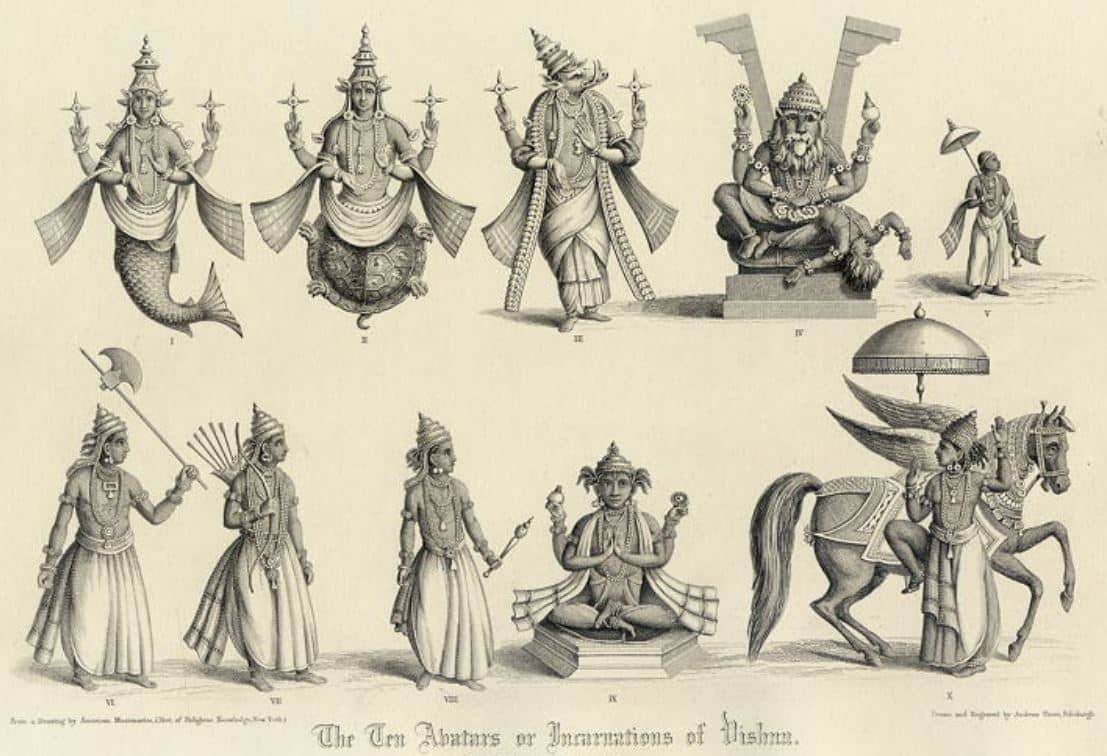
From Innumerable incarnations of Vishnu, Rishis or Sages selected ten Avatars as a representative of the rest; these ten incarnations are known in Sanskrit as “Dashavatar.” The Dhashavatara list of Vishnu is introduced in Garuda Purana (1st millennium BCE).
There are different versions of the Dashavatar list in different scriptures. The Agni, Padma, Garuda, Linga, Narada, Skanda, and Varaha Puranas list Buddha among Vishnu avatars. Some scriptures do not mention Buddha and Balarama in their list of Dashavatar. But, Vayu Purana replaces them with Dattatreya and Vyasa.
Vishnu Avatar list
Dashavatara order based on many Puranas is Matsya, Kurma, Varaha, Narasimha, Vamana, Parashurama, Rama, Krishna, Buddha, and Kalki.
The Shiva Purana has Balarama on the list as the 8th Avatar – Matsya, Kurma, Varaha, Narasimha, Vamana, Parashurama, Rama, Balarama, Krishna, and Kalki.
1. Matsya Avatar

Matsya is the half fish, a half-human avatar of Vishnu. Matsya Avatar of Vishnu is depicted as a four-armed figure with the top half of a man and the bottom half of a fish. According to Matsya Puran, Matsya tells Manu about the great flood and helps him save all the living beings, the Vedas, and the seeds of all plants.
Once Manu was washing his hands in a river. A little fish swam into his hands and asked him to save its life. Manu put the fish in a jar, but it soon outgrew the jar. He then moved it to a larger water body, but the fish outgrew that, too. No matter where Manu put the fish, it kept growing bigger and bigger.
The fish then revealed itself to be Lord Vishnu as a Matsya Avatara. The first avatar of Vishnu told Manu that a great flood was coming that would destroy all life on Earth. He helped Manu to save all the plants and animals he could find.
2. Kurma Avatar
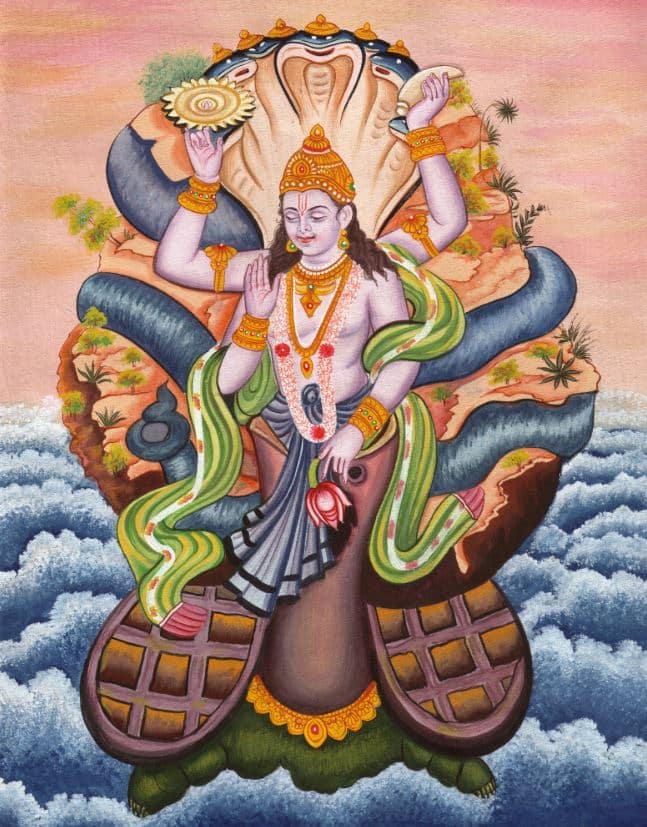
Kurma is the second avatar of Vishnu in a half tortoise half-man form. During the churning of the ocean (Samudra Manthan), he balances Mount Mandara on his shell to assist the gods and the asuras in the churning process.
During Samudra Manthan, Vishnu also took a female avatar, Mohini, to distribute the amrita, the nectar of immortality. As Mohini and Kurma avatars, Lord Vishnu plays a very important role in ending the hundreds of years of conflict between gods and Asuras.
According to Kurma Purana, the Kurma avatar of Vishnu supports the weight of the cosmos on his back. Whole consciousness rests on all-pervading Vishnu.
3. Varaha Avatar
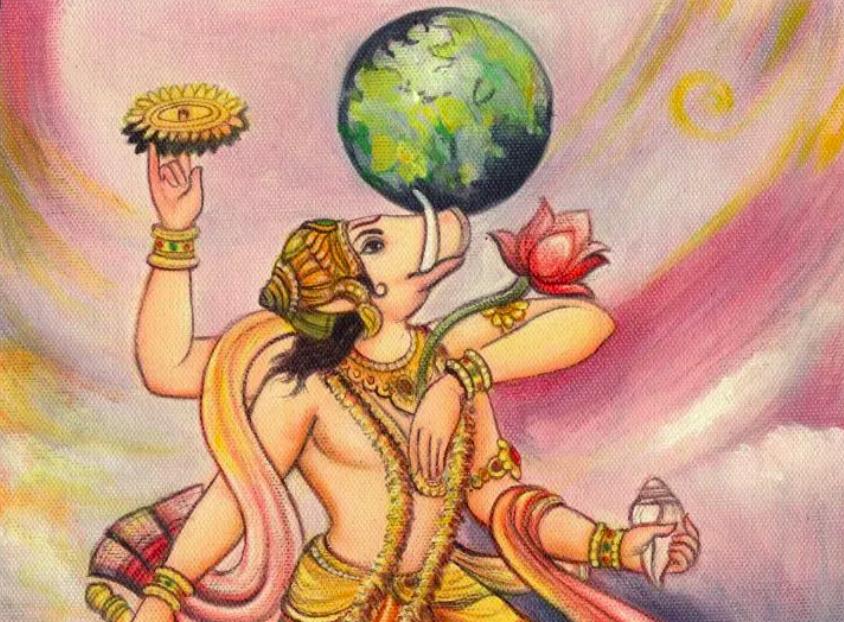
Varaha is the half-man and half-boar avatar of Vishnu. Hiranyaksh Kidnaps Bhudevi (the personification of the earth) and Submerges her in the cosmic ocean. Varaha fights the Hiranyaksha for 1000 years, kills him, and saves Bhudevi.
In his third avatar, Lord Vishnu restores Bhudevi back to the surface from a submerged state using his tusks. Varaha restored life on the earth as Vishnu is the sustainer of the universe.
4. Narasimha Avatar
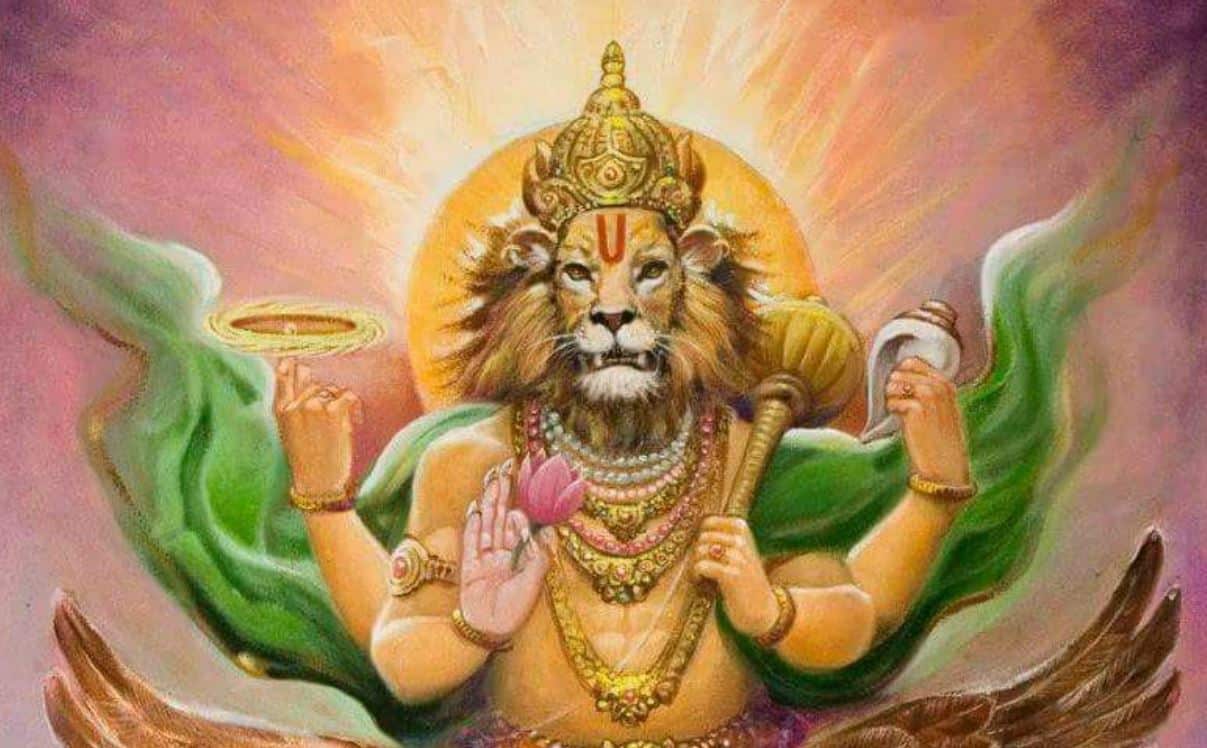
Narasimha is the half-lion and half-human avatar of Lord Vishnu. Vishnu took his fourth avatar to end the reign of the asura king Hiranya Kashyap and establish peace, order, and righteousness on earth.
Hiranya Kashyap (Hiranyakashipu) wanted to kill his own son Prahlad, a devotee of Vishnu. He had already tried multiple ways to kill him, but every attempt failed due to the power of devotion. He also lost his sister, Holika, in one of his failed attempts.
Since Hiranyakashipu was blessed with boons by Lord Brahma, Vishnu waited for the right moment to take the half-human and half-lion avatar and kill him.
5. Vamana Avatar

The 5th avatar of Lord Vishnu, Vamana, was a dwarf Brahmin. This Vishnu avatar comes to check the growing power of the Asura king Mahabali. Vamana, which he does by tricking him during a sacrificing ceremony and sending him to the underworld.
In his Vamana avatar, Vishnu attended the yajna organized by King Mahabali, who was well-known for his generosity. The King welcomed Vamana and honored him by offering him anything he desired. Brahmins were always held in high regard and were never turned away during those times.
Vamana only requested three paces of land. King Mahabali was surprised and asked Vamana to ask for more, but Lord Vamana refused to ask more. Mahabali granted the request, and the dwarf avatar of Vishnu transformed into a giant form to take everything in the universe in three steps.
Mahabali immediately surrendered to Lord Vamana after witnessing his real image. Due to his devotion, he was given Patala Loka and Deva Loka was given back to Lord Indra.
6. Parashurama Avatar

The Sixth avatar of Lord Vishnu, Parshuram, is depicted as a sage with an axe in his hand. He was born to end the tyranny of the evil Kshatriyas, who misused their powers, made others’ lives miserable, and brought them to justice.
Lord Parashurama was a Brahmin by birth, being a son of Sage Jamadagni. He was born in the Treta Yuga, and it is believed he will appear again in the Kali Yuga to guide the Kalki Avatar of Vishnu. According to Puranas, Parashurama is one of the Cheranjeevis (the immortal ones).
7. Rama Avatar
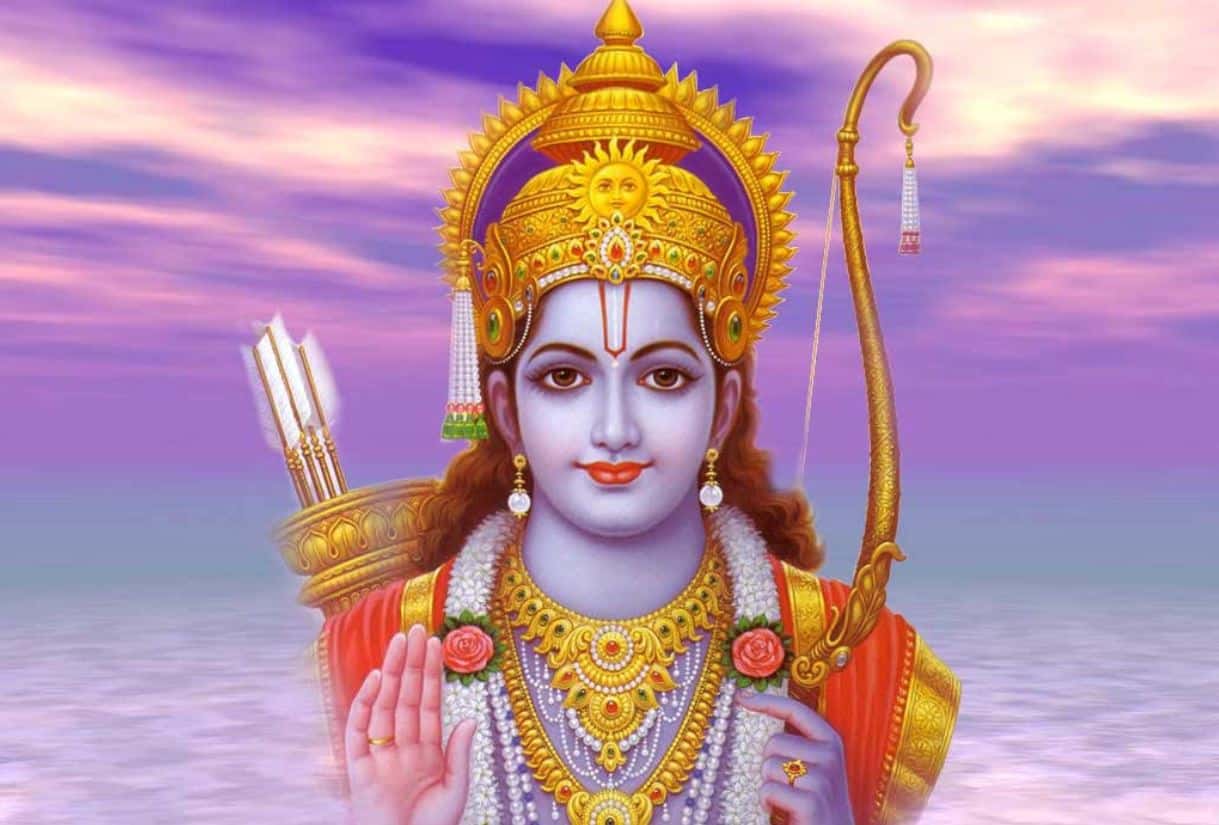
Lord Rama is one of the most significant and powerful deities of Hindu dharma and the lead character of the Ramayana. He kills the Ravana to end his tyrannical rule and liberate Goddess Sita, whom Ravana had abducted.
During the Treta Yuga, Ravana received a boon from Lord Brahma, making him very powerful and aggressive against demigods. He took control of Navagrahas and Deva Loka. To stop him, Vishnu took the Rama avatar to establish righteousness.
The seventh Avatar of Vishnu, Rama, was born as the scion of the Solar Dynasty in Ayodhya, the capital of the Kosala Kingdom. He was married to Sita, the daughter of King Janaka.
8. Krishna Avatar
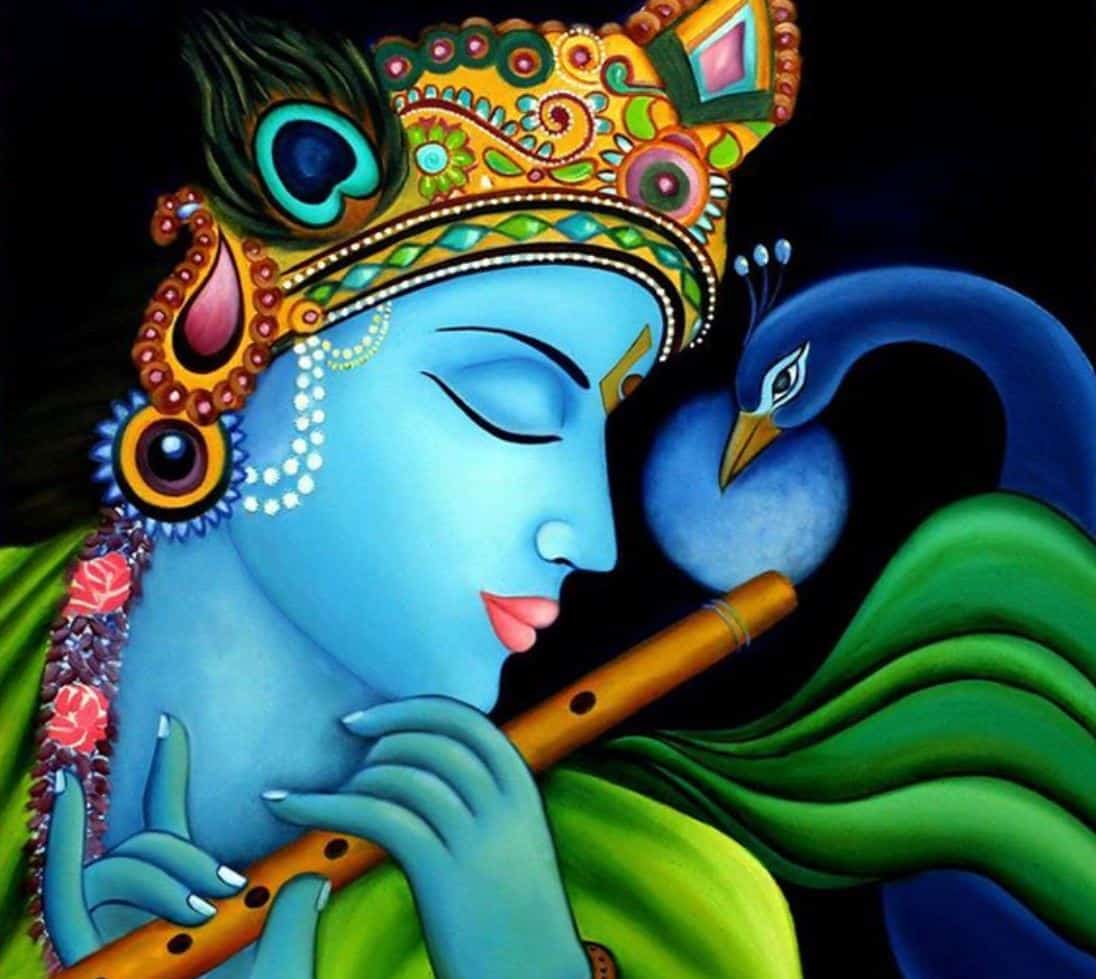
Lord Krishna is the eighth avatar of Lord Vishnu. He is known for ending the reign of his tyrannical maternal uncle Kansa and his role as the advisor of the Pandavas and the charioteer and guide of Arjuna in Mahabharata.
Lord Krishna and his brother Lord Balarama played a sustainer role during Dwapara Yuga. Lord Krishna played the role of a Guru and helped Arjuna win the great war of Kurukshetra and re-establish Dharma. Lord Balarama did not directly participate in the Mahabharata War, but he taught mace fighting to Bhim and Duryodhana.
9. Buddha Avatar
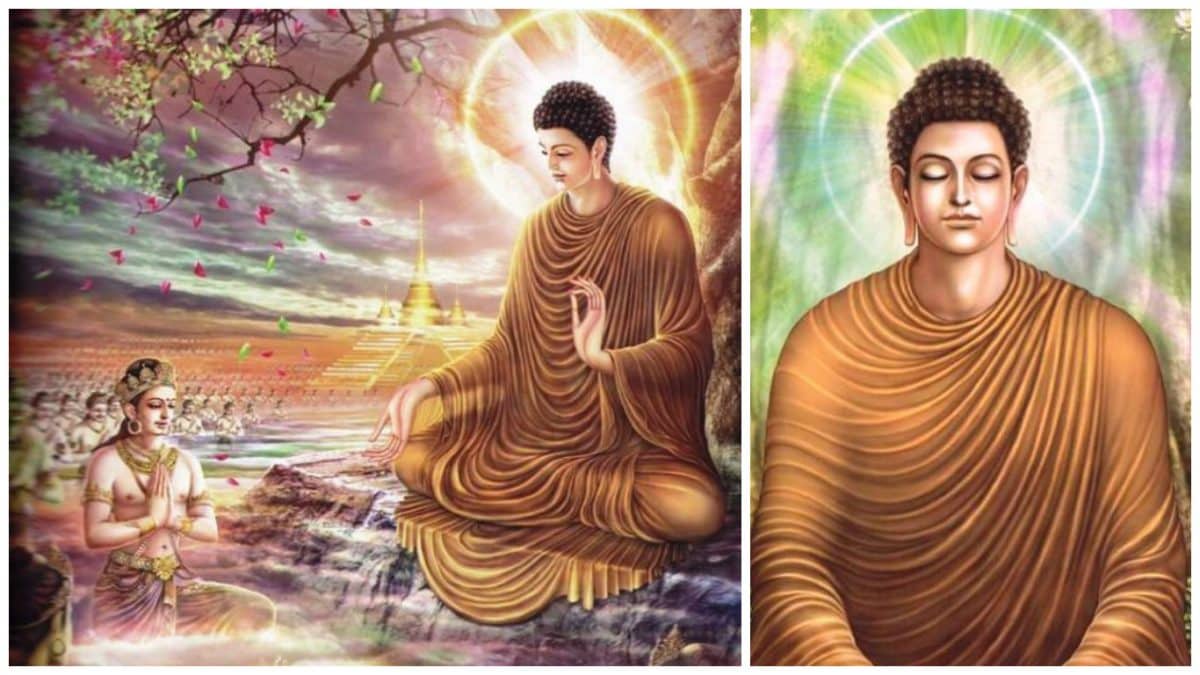
Siddhartha Gautam, later known as Gautam Buddha, is the ninth avatar of Vishnu. He left his family and all material possession in search of enlightenment. He founded Buddhism and taught people ways to end all kinds of suffering through the Noble Eightfold Paths.
Srimad Bhagavatam 1.3.24 talks about the Buddha avatar of Lord Vishnu.
तत: कलौ सम्प्रवृत्ते सम्मोहाय सुरद्विषाम् ।
बुद्धो नाम्नाञ्जनसुत: कीकटेषु भविष्यति ॥ २४ ॥tataḥ kalau sampravṛtte sammohāya sura-dviṣām
buddho nāmnāñjana-sutaḥ kīkaṭeṣu bhaviṣyati
Translation: Then, at the beginning of Kali-yuga, the Lord will appear as Lord Buddha, the son of Añjanā, in the province of Gayā, just to delude those who are envious of the faithful theist.
Some scholars also think the Buddha avatar of Vishnu is – Adi Buddha, not Siddhartha Gautam.
10. Kalki Avatar

Kalki is the only avatar of Vishnu that is yet to be born. He will end all evil by defeating the demon Kali and starting a new Satyayuga or Kalkiyuga. Asura Kali is all the negative emotions and elements personified into one. Kalki is depicted as a warrior riding a white horse and holding a shining sword.
The last section of Srimad Bhagavata Purana talks about Kali Yuga and its effects.
